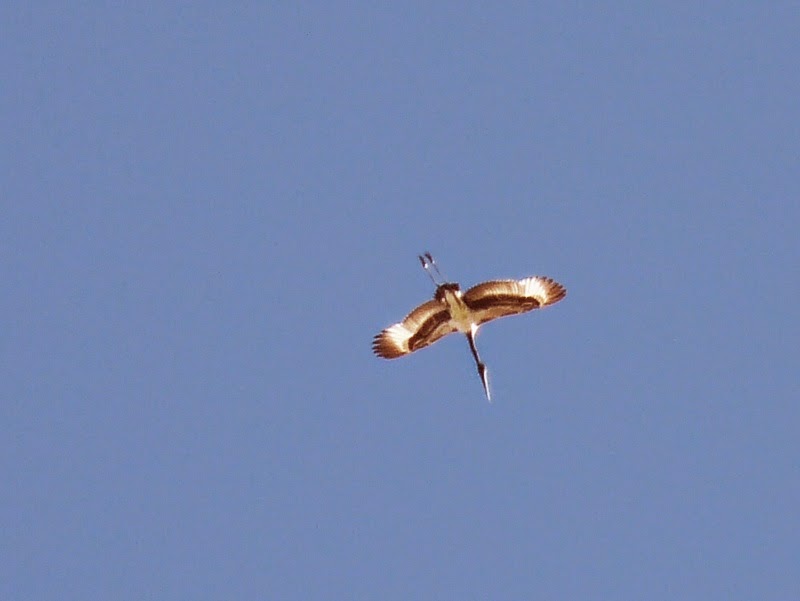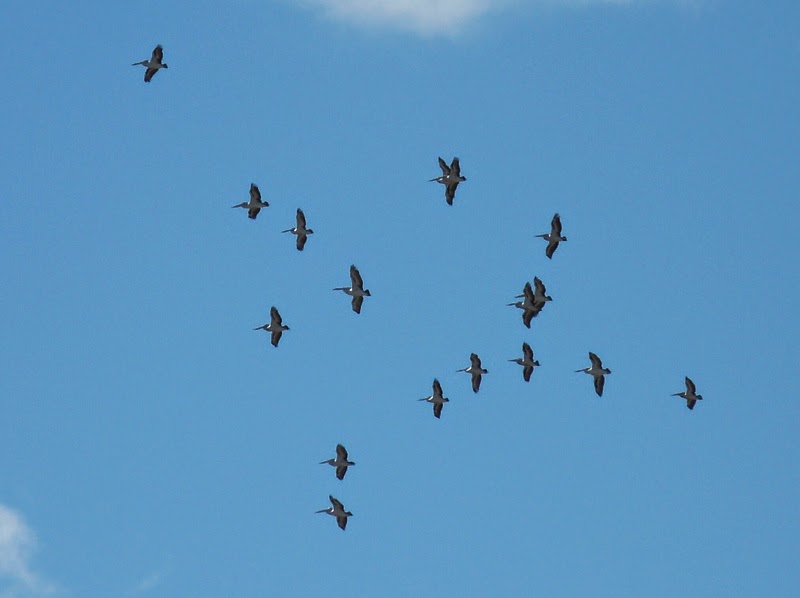It's been a while now since I waxed lyrical about the amazing spin-off of flight called hovering. It is an extraordinary achievement, but there is another extreme to flying that only a very few species have ever achieved.
 |
| Female Magnificent Frigatebird Fregata magnificens, Galápagos. She accompanied our boat (with many companions - see below) for kilometres, and I don't recall once seeing her flap. |
Strictly, she was not flying, but soaring. Perhaps this is being a bit precious, but it does seem important to make the distinction or we'll miss out on understanding this extreme of flight. Flying is, in technical terms, 'assisted aerial motion', which can also be stated as 'flapping your wings'. You need to be able to flap fast enough to overcome the drag of air along and behind your body. To accelerate or climb you must flap even faster still.
Soaring however, as I observed in the caption above, involves not flapping your wings. The energy in this case comes from the air around you, which may be deflected up (eg from a boat pushing through it, or from an air mass moving over a ridge-line or a mountain) or from rising thermals of warmed air, over a sand dune or even a city. The frigatebirds were using this energy to move forwards; birds which rise on a thermal can then soar for tens or even hundreds of kilometres, losing height only incrementally as they go. In any case, as you could imagine, very complex and precise adaptations of both physiology and shape are required; it seems that only some larger birds and pterosaurs have ever mastered the art.
Mathematically, the best shape for a soaring wing is the one exhibited by the frigatebirds above; it is very long and slender and pointed, and known in the trade as a 'high aspect ratio' wing. Aspect ratio is defined as wingspan squared divided by wing area - in other words a high aspect ratio means a very low wing loading, or very little weight per square centimetre of wing. This allows very slow flight without stalling, and facilitates 'riding the wind'. (It's also good for hovering, but that's another story.)
| Waved Albatross Phoebastria irrorata. Española, Galápagos. Albatrosses are also consummate soarers and utilise high aspect ratio wings. |
However, everything in nature is about trade-offs and compromises, and most soaring birds do not have these very long slender wings.
 | |
| Straw-necked Ibis Threskiornis spinicollis soaring, Grenfell, New South Wales. (I love the way the two birds on the left are undertaking running repairs to their feathers.) |
These ibis are soaring on very differently shaped wings from the ideal. The problem with the high aspect ratio wings is not with their undoubted efficiency in the air, but the problems they pose in getting there. Simply, they are so long that a normal takeoff is very difficult to achieve; they bang on the ground when being flapped! Large birds which possess them must either launch into the air from a high point (such as a cliff, which is what the Waved Albatross on Española were doing) or using wind energy to get into the air (which both albatrosses and frigatebirds also so).
The ibis use the compromise solution, known somewhat inelegantly but descriptively as 'soaring wings with slots'. These wings are broad and long, with deep slots between each primary feather to reduce air turbulence around the wing tips and promote easy soaring. While slightly less efficient than the albatross wing, they are shorter and enable relatively easy takeoff from the ground.
Not only is soaring only effectively available to large birds (and formerly pterosaurs), because only they can have the large wing area to body weight ratio required, but the reverse is true too. As birds get closer to the cut-off maximum flying weight of around 15kg (the largest eagle, swan, condor, pelican, albatross and bustard are all about this size), soaring becomes the only realistic option, as sustained powered flight would be just too energy-intensive.
And with that, let's end by simply admiring some other magnificent soarers.
| Black-breasted Buzzard Hamirostra melanosternon, Uluru, central Australia. Many soaring birds have black wingtips, because the melanin confers resistance to wear. |
 |
| Andean Condor Vultur gryphus, Los Glaciares NP, Argentina. One of the great soarers! |
| Galápagos Hawk Buteo galapagoensis, Santiago, Galápagos. |
| White-bellied Sea Eagle Haliaeetus leucogaster, Esperance, Western Australia. A magnificent sight soaring along coastlines (and sometimes well inland) from India to southern Australia. |
| American Swallow-tailed Kite Elanoides forficatus, Ecuador. One of the smaller soarers but an efficient one, which in part uses the skill to glean prey from foliage. |
 |
| Black-necked Stork Ephippiorhynchus asiaticus. Muttaburra, Queensland. |
 |
| Australian Pelicans Pelecanus conspicillatus, Muttaburra, Queensland. Pelicans constantly criss-cross the continent by using rising thermals, especially over sand dunes. |
Soaring, just another wonderful aspect of this wonderful world, and perhaps one we don't think about enough.
BACK ON THURSDAY